We are excited by the growing use and impact of Talking Mats in CAMHS. With this in mind, we have updated our compilation of mental health blogs, and are pleased to share a new compilation with you. If you have used Talking Mats in a mental health setting and would like to share your experiences with us, please do get in touch at info@talkingmats.com – we would love to hear from you!



You can also access the blogs listed above by clicking the following links:
Our thanks for this blog go to Olivia Ince, Talking Mats Licenced Trainer and Speech & Language Therapist. This blog post reflects on the use of a Talking Mat with a Thinker called M who speaks English as an additional language. The Listener in this Talking Mat is Jono Thorne who is a colleague of Olivia. Jono did this Talking Mat for his video as part of a Foundation Training course run by Olivia.
M is a young adult who came to the UK as an unaccompanied asylum-seeking child. M is from a country in Central Africa and speaks a language which is not widely spoken outside of the region. Accessing interpreting and translation services in the UK for their native language is very difficult and M has therefore had difficulties learning English. This means the people around M often have difficulties finding out M’s views, which is why Jono thought a Talking Mat could be an invaluable communication tool for M.
M already uses some visual support, for example hand gestures and using objects such as food items when having a conversation in the kitchen. The people around M are unsure what M’s level of comprehension is in English and therefore they make adaptions such as simplifying their language. M’s expressive language in English is typically the use of one- or two-word utterances and yes/no responses.
To see if M would be able to engage with the Talking Mat process, Jono chose a simple topic to start with and one which he knew would interest M: food. The Top Scale used was like/unsure/ don’t like. Jono noted that M quickly understood the concept of the Talking Mat and the visual element seemed to support M’s understanding. The Talking Mat process including the side-by-side listening also facilitated rapport building.

Jono noticed that M was decisive and seemed certain about their placement of the option cards. The Talking Mat helped M to share their views on a larger number of items than would likely have been possible via a verbal conversation. M also joined in with the recap of their Talking Mat as part of the review and reflect by reading out the Option cards with Jono, which meant M was even more involved with the process.
There were a couple of difficulties for M during the Talking Mat process: the blanks and the option to change where the Option cards were placed. Jono tried to explain these steps using simple language but M did not appear to understand these concepts due to their level of comprehension of English. As M had seemed sure of their initial placement of the Option cards and they joined in with the recap, Jono felt that the Talking Mat was an accurate reflection of M’s views that day. Continuing to model these steps to M will likely help them to develop their understanding of these parts of the Talking Mats process over time.
Jono reflected on how useful it was to now know which foods M likes and doesn’t like. He also reflected on the potential future use of Talking Mats with M on more complex topics and to facilitate participation in decision-making now that it’s clear M understands how a Talking Mat works.
If you are interested in completing Talking Mat Foundation Training, you can read more about it here.
Thanks to Julia Pollock, Highly Specialist Speech and Language Therapist (SLT) from the REACH team in Perth for the second part of this latest guest blog sharing information about our exciting project, which has aimed to produce a resource to open up conversations with young people about sex.
By far, the most impactful feedback we’ve had during the pilot stage of this project has come from the social worker of the young person who I initially created the resource for. She was very keen to share with us that she had used the resource with the young person (two years on) and said it was ‘absolutely fantastic – I can’t tell you how good it was’.
Using the updated version, she was able to revisit the young person’s sexual knowledge and understanding and found that he was able to understand and have adult discussions around much more complex and abstract concepts than he had previously. The concepts included consent, contraception and sexually transmitted diseases. This was in stark contrast to his initial bewilderment when we first introduced the resource to him!
This has been a perfect case study for us as the resource has been used to support this young person through their entire criminal justice journey and through their sexual development into adulthood. The first draft had been used to initially gather information about his sexual knowledge and understanding in addition to information about the harmful sexual behaviour. It was later used to guide and support his sex education.
Now we have come full circle, with social work using the updated version of the resource to reflect on the past, helping him to understand his sexual development and to help guide his understanding around navigating future adult relationships in a safe and appropriate way.
‘He is ‘a confident, happy young man with the knowledge he needs for the future. There has been a lot of repair to his sense of self and moving from describing himself as a “monster” to understanding that he had a lack of knowledge and didn’t have the skills to navigate his sexual development safely. He is now able to accept his sexual feelings as being a “normal” part of development and to think how these can be expressed safely. His ability to integrate knowledge/reflect has been remarkable!‘
‘Importantly, we have also worked hard with the family to help them to accept him developing into a young adult with sexual feelings and the need to have access to peer relationships.‘
‘The Mat was brilliant in bringing all this together and providing the scaffolding to have these discussions with him.’
As a speech and language therapist, this process has been such a fantastic learning experience. It has been a joy and a privilege to work together with our social work and Talking Mats colleagues to create what will hopefully become an invaluable and essential resource in this field.

We are looking forward to sharing more information about the project and resource in an Advanced Webinar for practitioners who have already completed Talking Mats Foundation Training, in September 2024.
Inspired to think about Talking Mats Foundation Training? Find out about all the options we have available here.
Talking about sensitive issues can be challenging at times. We are so excited to publish this guest blog from Julia Pollock, Highly Specialist Speech and Language Therapist (SLT) from the REACH team in Perth, Scotland, explaining how a newly developed Talking Mats resource helps to open up conversations with young people about sex.
REACH is a unique team, one of a kind in Scotland, that provides intensive support for care experienced children and young people on the edge of care in Perth & Kinross. We are a multidisciplinary team bringing together professionals across health, education, social work and youth work. This allows us to provide prompt specialist care, while limiting the need for referrals to multiple agencies.
My colleague, Janie Scott, and I have worked for REACH since its inception, as Highly Specialist Speech and Language Therapists. Research shows that more than 60% of care experienced young people have some kind of speech, language and communication need (SLCN) and at REACH we work on the assumption that our young people may have an SLCN – until proven otherwise. This means that we routinely offer communication assessments and support to every single young person (and their parent/carers), in addition to keeping inclusive communication at the heart of everything we do. Adopting this approach ensures that none of our young people have to struggle with communication difficulties unsupported.
Working in a multidisciplinary team with a heavy social work contingent has been a very different experience for Janie and I. The team were open to our training and approaches and allowed us the freedom and autonomy to shape our own SLT service.
One of the first things we did at REACH was to introduce Talking Mats. We are both Talking Mats Licensed Trainers. All our REACH staff, as well as any other colleagues across the council and NHS who also work with our young people are Talking Mats trained.
Despite some initial scepticism around using pictures with teenagers, the resource has since proven to be incredibly useful and engaging for this particular client group. It has now become a staple resource that our staff will reach for regularly to facilitate conversations with our Young People and to help them express their views on complex issues.
Our young people can occasionally find themselves in conflict with the law and wrapped up in the complexities of the criminal justice system, as a result of their often disadvantaged backgrounds, and/or due to a range of ongoing challenges such as developmental trauma, social emotional and mental health difficulties, and/or Speech, Language and Communication Needs (SLCN). In addition to supporting REACH clients through their criminal justice journey, our team also specialise in harmful sexual behaviour assessments, for both internal and external clients.
The idea for a Talking Mats resource for harmful sexual behaviour initially came from one of our Senior Practitioner Social Workers, Amy MacKinnon, who suggested that Talking Mats might be a useful tool to support their harmful sexual behaviour assessments (AIM3). The assessment, which involves interviewing the young person about incredibly sensitive and personal issues, can be quite confronting for young people. We discussed the possibility of having visual resources which would not only cater to the SLCN of our clients, but that would also make the assessment feel less intimidating for the young people, encouraging more open and honest responses.
We often start by assessing a young person’s existing level of sexual knowledge and understanding, as how can young people possibly share their version of events if they do not understand the basic concepts of which they were being accused of?
This includes exploring their understanding of the language around sexual physiology and anatomy, in addition to the social and legal considerations of sexual behaviour. The introduction of this resource allowed us to explore existing knowledge much more effectively than we had previously, with a more logical progression of concepts ranging from the very concrete language for body parts, through to more abstract ideas such as consent. More careful consideration of the young person’s language level really helps to ensure that the Young Person’s responses are accurate. We recognised that our existing pictures/resources needed development and so I approached Talking Mats to ask if they would consider working with us to create an official Talking Mats resource using their own artwork and branding. I know from experience that their artist, Adam, always does a fantastic job creating simple images that are so easily understood while also being sensitive and inclusive.
We developed a small working group with a handful of REACH and Talking Mats staff who have focused on developing a new healthy relationships resource to open up these tricky conversations. We have now completed the pilot stage, and have a fantastic resource. Talking Mats did not disappoint and as expected, they worked wonders with the images!
One interesting development along the way was the group’s reflection that the resource had felt quite negative and that perhaps we should keep a more neutral stance when developing the concepts – leaving room for much more general (or even positive) discussions around sexual development too. This allowed us to expand the resource to include concepts relating to puberty and gender identity. We felt that this would make the resource more far-reaching and impactful, while still retaining the option to use the more niche resources for addressing harmful sexual behaviour, when required.
The feedback we have received has been overwhelmingly positive, with comments such as ‘It’s amazing’ and ‘We’ve been sitting waiting for a resource like this.’ Those trialling the resource for us unanimously felt that the resource helped them to discuss the topic with their clients, helping to ‘open up’ discussions that would otherwise be more challenging to initiate. We have also received a lot of positive feedback on the clarity of the concepts and images; the consensus being that the visuals are easy to understand and unambiguous. This is fantastic feedback given the complex and abstract concepts we were tackling with this resource!
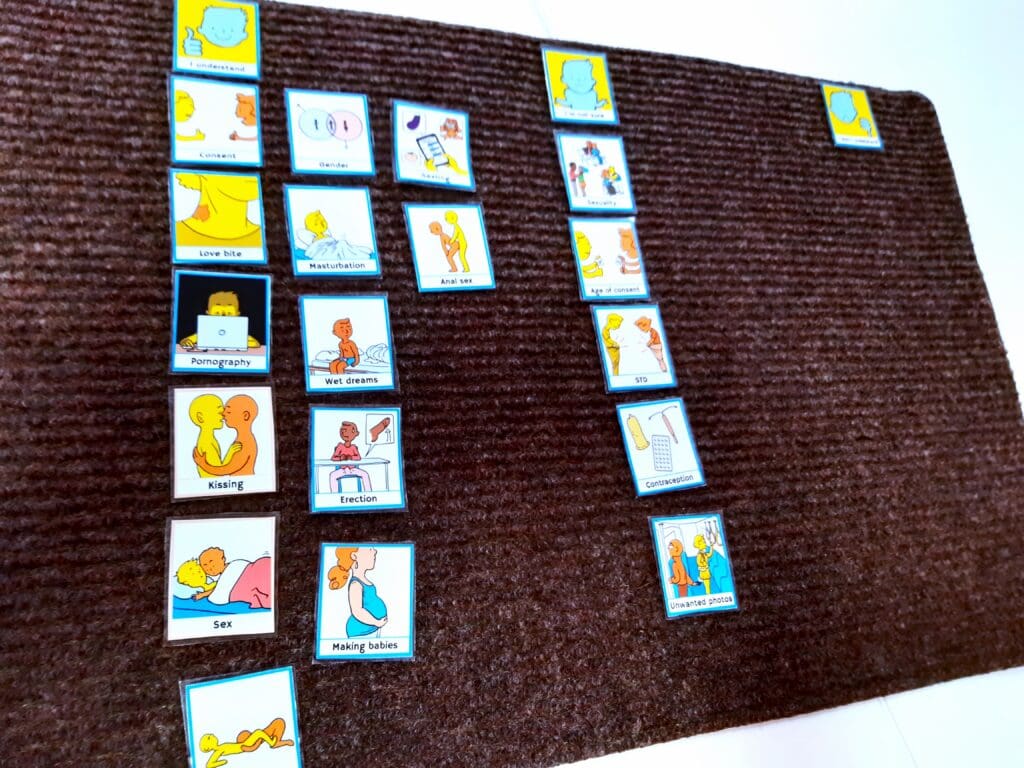
We are looking forward to sharing more information about the project and resource in an Advanced Webinar for practitioners who have already completed Talking Mats Foundation Training, in September 2024.
Look out for the second part of Julia’s blog next week, to read one of the powerful examples of the positive impact this resource has already had.
Inspired to think about Talking Mats Foundation Training? Find out about all the options we have available here.
Communication is a fundamental human right, yet many individuals with communication difficulties face daily challenges in expressing their thoughts, needs and feelings. Augmentative and Alternative Communication (AAC) is a powerful tool that bridges this communication gap, and Talking Mats is one innovative approach that has proven highly effective in enhancing the lives of those who use AAC.
However, in the 25 years that Talking Mats has been developing resources we have never created one that specifically addresses the needs of AAC users.
Until now!
The new resource, Supporting Communication with AAC and the online advanced training module, AAC will be launched at this year’s Communication Matters Conference 9th-11th September.
The idea
Ace Centre first contacted us in 2018 with the idea of developing a specific assessment resource that would allow the person considering using AAC to express their views about it; were they ready to use AAC, did it fit with their life and communication needs and how much support would be required? This could then inform decisions around referrals onto specialist AAC services.
Development
As with all Talking Mats resources, this one was piloted and discussed and changed until the final version was reached. Thank you to all the practitioners and clients who gave their time and energy in that process. Thank you also to the Scottish Centre of Technology for the Communication Impaired who also collaborated on the resource and the module.
Outcome
The outcome is a resource that can contribute to both assessments and reviews, and an Advanced online training module, both of which aim to put the AAC user at the heart of decision making about their communication.
Here is a brief outline of the resource and the module.
Supporting Communication with AAC (card and digital resource)
Topics
Your Communication
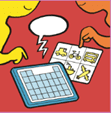
This topic considers the ‘How’, ‘Who’ and ‘Where’ of interactions and helps develop an understanding of the Thinkers communication needs. It can be completed when you are getting to know the Thinker.
Joining in conversations

These topics are designed to help a Thinker explore how they feel about their AAC resource when it comes to joining in conversations and reflect the fact that an individual often uses a combination of communication modes to be effective. The three topic cards are: Verbal conversation, Paper support and Electronic Support.
How your AAC works
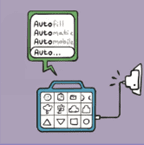
This topics explores different ways of accessing the AAC device as well as the different features it has, incluing functions, appearance, sound, and access.
If you are trained in Talking Mats to Foundation level you can buy the resource from our website
AAC Advanced module
To access this course you must have already completed the Foundation Course.
The objective of this course is to ensure that AAC users are at the heart of decision making and that necessary adaptations are in place to support those conversations
The course is split into three different sections:
The Resource
Aim – to recognise the different topics and who they might be suitable for
Access
Aim – to recognise different positions, places and methods for a Thinker to access a Talking Mat
Communication Dynamics
Aim – to recognise the dynamics in a conversation, and appraise the process of using additional people during a Talking Mat
To successfully complete the course participants must pass the quiz and contribute to the forum telling us about their experience.
Courses will run from the 1st of every month starting in November.
Talking Mats: developed in Scotland, embraced world wide with close working relationships in Japan, Sweden, Australia and New Zealand, but can the framework be adapted to reflect different approaches to communication that these diverse cultures embody? Victoria Mardell’s discoveries offer a fascinating insight into differences between Western communication and that of the Māori culture showing that the Talking Mats framework can be a cross culture communication tool.
Using Talking Mats in Te Ao Māori (The Māori World)
A Non-Māori SLT’s collaborative journey to deeper understand whether the Talking Mats process is culturally responsive to Māori
My Project
Working for the Aotearoa New Zealand Ministry of Education, I was approved to undertake a project which would investigate the suitability of Talking Mats to capture child voice.
A key part of this project was to review whether Talking Mats were culturally responsive to Māori and reflective of Māori worldview and if not, whether they could be altered accordingly.
This led to a rewarding journey for me as a non-Māori practitioner as I was able to collaborate with Māori colleagues and improve my cultural awareness. I got to experience Māori ways of gathering and acquiring information and I came away with new perspectives, which have shaped my practice.
Information Gathering: Learning About and Holding a Wānanga
To gather the information needed, it was suggested that I hold a wānanga. The word ‘wānanga’ would loosely translate as a “forum” in English. However, a more accurate description would be a collaborative process which involves engaging, sharing, and reflecting, with space for all viewpoints. A wānanga would often lead to the creation of new knowledge and decision-making.
This was my first experience with a wānanga and whereas Western ways of acquiring knowledge would likely have placed myself as an “expert”, seeking “feedback”, the wānanga was an unhurried deep discussion, in which all participants were partners, collaborating on an important subject.
Findings
There was overall agreement that Talking Mats are a good fit with Te Ao Māori.
Talking Mats were seen as a good way to promote Mana Motuhake (self-determination) and whakamana (giving prestige to children and their families).
Te Ao Māori (the Māori worldview) is strengths-based and the wānanga participants thought Talking Mats was a good fit with this approach.
Some considerations were discussed:
Codesigning the top scale: Participants discussed that concepts such as “going well” “not going well” are Western and that if a Talking Mat was used in a Māori kura (school), or with a Māori whanau (family), then categories might need to be adjusted or changed. This could be done via discussion and collaboration.
Māori colleagues have also shared some ideas with me for potentially suitable top scales:
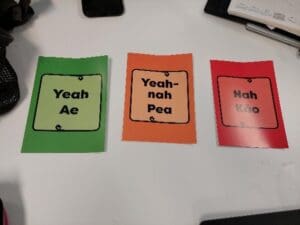
(Sonja Macfarlane, 2021)
The key point was the importance of collaborating on the top scale rather than having this pre-determined before delivering the Talking Mat.
Being mindful about predetermination: Participants discussed how a practitioner turning up with a Talking Mat and a set of visuals might be seen as pre-determination and this could lead to discomfort and resistance. It would be more helpful if the practitioner facilitated a discussion, with the use of drawing visuals ‘on the fly’ as well as using the Talking Mats visuals. In practice this could look like a more collaborative process, with a greater input from the thinker in the early stage of the mat, rather than just at the end.
Action points may be strength-based rather than deficit-focussed: We discussed how there is a tendency in Western thinking to set goals or action points around improving things which the thinker has identified as not going well. However, in keeping with a Māori worldview, actions points might be to do more of what you already like, or to mentor others. We need to be careful that as practitioners, our unconscious bias is not inadvertently encouraging the thinker to focus on areas they have rated negatively.
Practice Example and Changes to my Practice
During the wānanga my former colleague, a Māori SLT, shared an example of a Talking Mat she had done about how a student wanted to participate in kapa haka (group performance of Māori dancing and chanting).
The SLT created her own visuals to reflect the kapa haka process. During conversation the SLT and student discussed how she could fatigue easily so the SLT drew an option to sit or stand. The action point was for the student to participate in waiata a-ringa (action song), with an option to sit if fatigued.
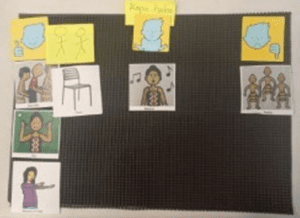
The process of considering Talking Mats through a Te Ao Māori perspective has changed my practice and I am grateful to my Māori colleagues for their time and insights. I am now more mindful when reviewing a Talking Mat, to make sure the action points are coming authentically from the thinker. I am also a lot more collaborative in the visuals and top scale of the Talking Mat. I have found that practising with more collaboration has led to better relationship building and more in-depth conversations.
Mauri Ora
Thank you to Victoria for her work on this blog. If you have any questions about this please contact us on info@talkingmats.com
Question: What is a Talking Mat?
Answer: Talking Mats is a visual communication framework which supports people with communication difficulties to express their feelings and views.
That’s what our website says in black and white and you wouldn’t be alone in thinking it actively excludes people with a visual impairment. However, one of our Licenced Trainers and Speech and Language Therapist, Olivia Ince recently got in touch to share a story of a creative and innovative approach to using the tool; a Braille Talking Mat.
The mat was facilitated by an Outreach worker for Children with disabilities (the listener) who had been trained in Talking Mats by Olivia. The young person sharing their opinions (the thinker) has a genetic neurodegenerative disease which affects the nervous system, causing progressive difficulties with physical and cognitive skills including communication impairment and vision loss. The Outreach worker and Olivia worked on the project together.
Trialling a Braille Talking Mat
We have been working together on a project to trial a Braille version of a Talking Mat. Talking Mats is a visual tool, but we knew that a Braille version could work in theory if some adaptations were made and if the thinker had the cognitive ability to understand the Talking Mats process.
We thought a Talking Mat would be a good approach for this young person because it could help to make the conversation more engaging and create a more balanced interaction than asking a long list of questions. For this young person, the Talking Mat was primarily a thinking tool.
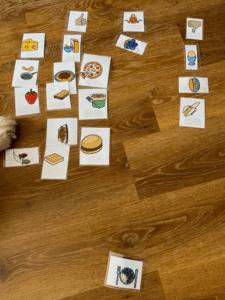
Introduction:
We started the process by introducing a concrete, familiar topic; food with the topscale of ‘like/ don’t know / don’t like. Using a concrete topic like food meant that the listener could discuss the responses with the young person’s wider network and find out if the mat was a true reflection of food preferences, thus giving further insight into the young person’s understanding of the Talking Mats process.
Adaptations:
The support team had access to a Braille machine which meant that a Braille sticker could be added to each laminated symbol card in the Talking Mat. Having both Braille and symbols on the cards meant that the Talking Mat was meaningful to the thinker and the thinker’s network, as a photo could still be taken as a record and to allow any actions to be followed up.
As usual, the listener handed the card to the thinker which allowed them to read the Braille.
- After reading each option card, the thinker then passed the card back to the listener and told the listener where to place each one under the top scale.
- At the end, the listener asked the thinker if they would like to read the Braille on all the cards again as part of the review and reflect. The thinker did not wish to do this, so the listener verbally reviewed the Talking Mat for the thinker.
We considered the alternative approach of guiding the thinker’s hand across the top scale allowing them to read the Braille after having read the Braille on each option card. The thinker could then have placed each option card under the top scale with some hand over hand guidance, but this was decided against due to the increased physicality and cognitive load of this additional action for the thinker.
Reflections:
When the Talking Mat was initially discussed the young person expressed curiosity about what it was and how it worked. Throughout the session they appeared to feel involved, enjoying the tactile and interactive nature of the Talking Mat process, increasing engagement with the process.
The Talking Mat helped the thinker to share their views on a wider variety and greater number of options than what would have been possible in a verbal conversation on the same topic. The Talking Mat also facilitated a more structured, empowering and accessible interaction for the thinker and created the time and space for them to share their views.
Now that this trial Braille Talking Mat has demonstrated that the thinker can engage in the Talking Mat process from start to finish and that they seemed to enjoy sharing their views using this tool, in future further Talking Mats could be used to help the thinker share their views on more abstract, emotive topics.
Overall, this project has shown that a Braille version of a Talking Mat can successfully support people who have a visual impairment to share their views.
If you would like to find out more please contact us on info@talkingmats.com and questions can be passed onto Olivia.
Licenced Trainer and co-developer of the Funeral Planning Resource, Gillian Robertson is running Talking Mats Foundaion Training with specific sessions relating to the Resource. To reflect the working hours that practitioners interested in this may we are offering these sessions outside the 9am-5pm ‘norm’.
- Live video link (Teams) over 4 sessions, from 7pm until 8.30pm. 16th October, 23rd October, 13th November and 4th December (all sessions must be attended). 16 places available
- Face to face training at our headquarters in Stirling. 2 half day sessions, 7th February 2024 and 6th March 2024 (both sessions must be attended). 8 places available.
Gillian Robertson, an Interfaith Celebrant with a background in Special Education, instigated and drove this project with funding from the Big Lottery Awards for All. In a previous blog she describes her motivation and the early stages of the project.
Here’s a bit more information on the topics and who might use them.
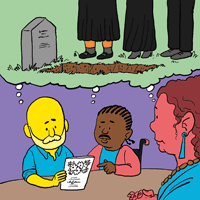
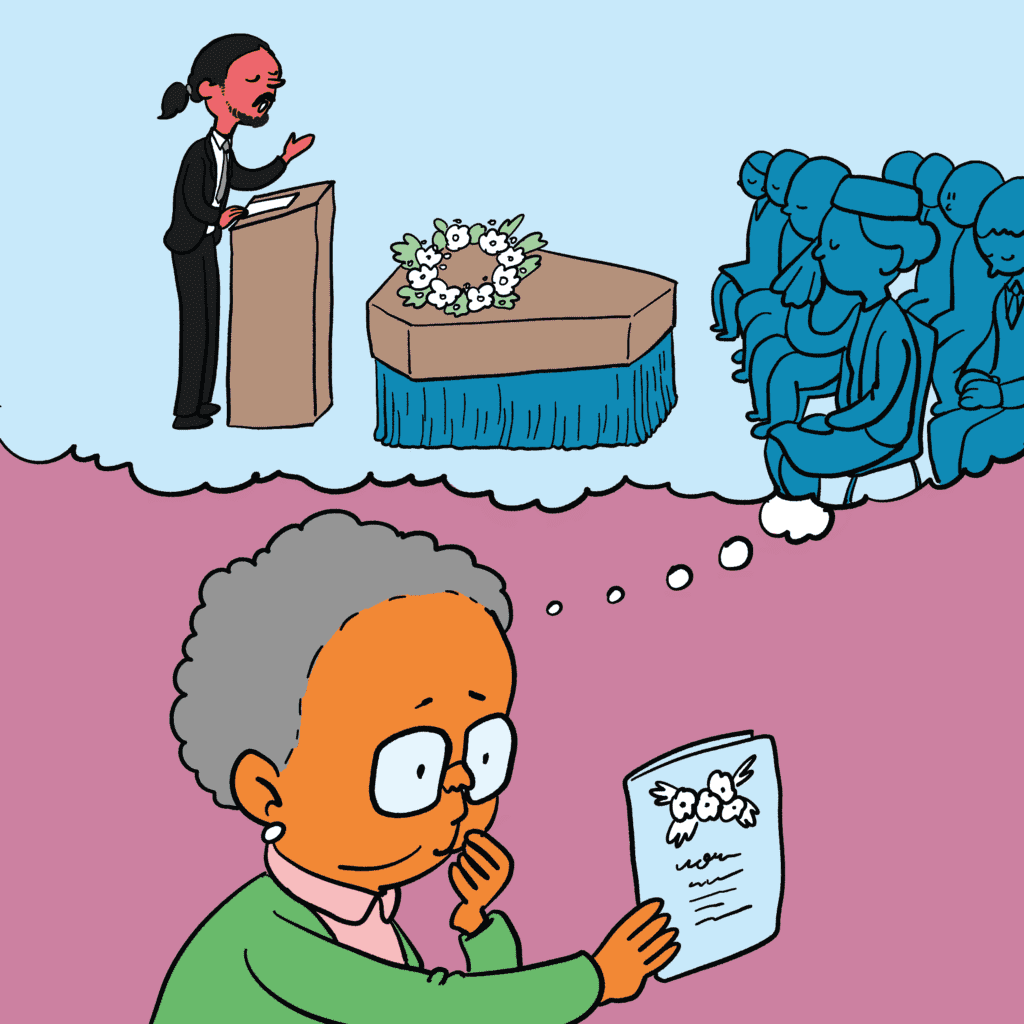
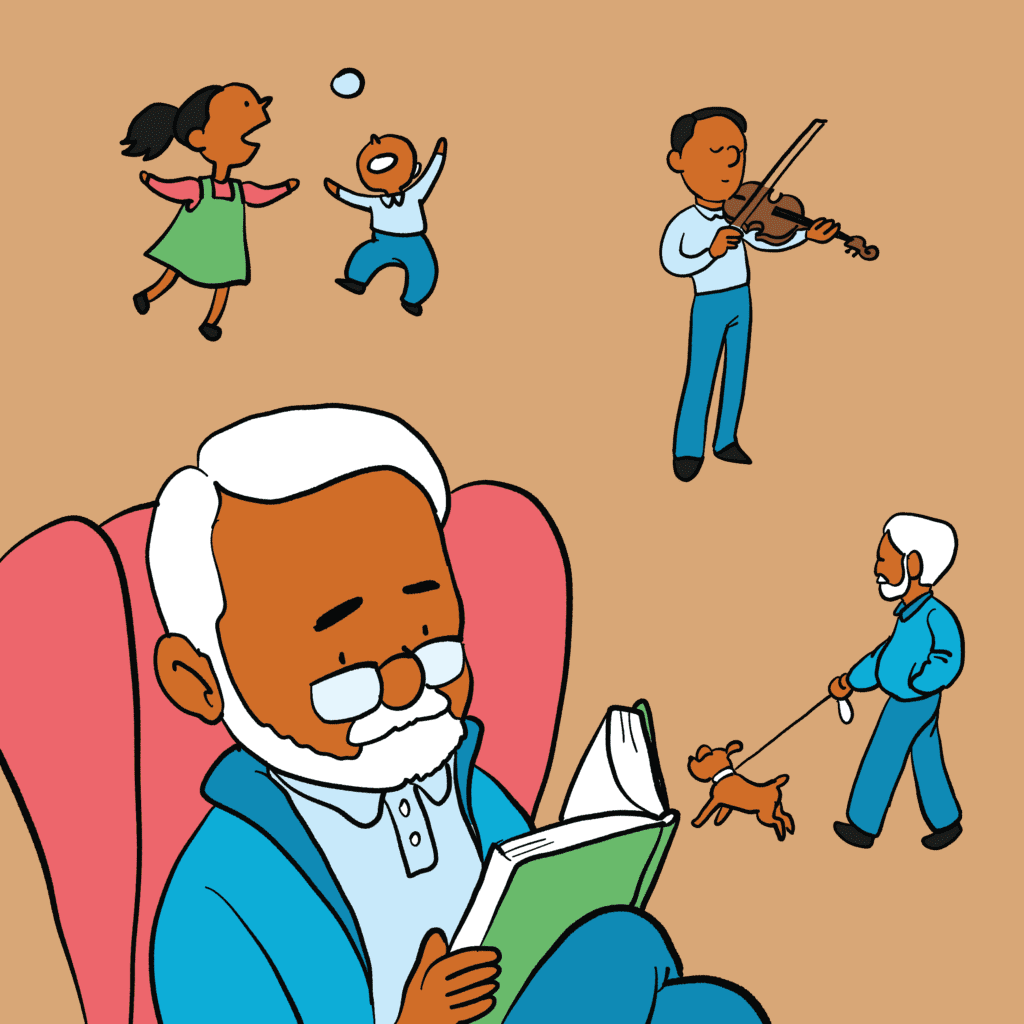
Funeral planning – this topic supports the initial conversation in planning a funeral leading to decisions about what someone would or would not like. It is particularly useful when planning for the future but can also be used by a celebrant / religious leader or funeral director to discuss what the family want for their loved one after a death has occurred.
Funeral Service – this topic supports the conversation which would follow on from Funeral Planning, leading to decisions about what someone would like or not like for the actual funeral service. Recording the first mat on this topic is a useful tool to refer to as plans progress. Who carries out this conversation depends on the context it is being used in. For example, if planning the service of a family member who has recently died then this is a very helpful resource for the celebrant or religious leader.
Eulogy – This topic supports conversations which highlight the important themes that someone would want included in their Eulogy. It is most useful when planning a service for someone who has recently died and relevant for the celebrant / religious leader to carry out when planning the service. The testing phase also highlighted that this topic can be used as part of the grieving process in a reflective way to help someone with learning disabilities remember the person who has died.
At the close of the project, with the testing phases completed, Gillian reflected and summed up the importance of this resource beyond the planning of funerals.
“The values behind Talking Mats are about making sure that everyone has a voice. If we deny people the ability to be heard, we deny them their human rights. When people’s voices are heard, improvements in their lives can be made.”
Foundation Training based on the resource is now available to book. There is a 20% discount if you attended the launch seminar and have the code to use at the shop checkout.
Walking Back to Happiness.
We may not be able to guarantee happiness but our friend and advocate, Karen Mellon is running a further training on our Foot Care resource and that is definitely something to sing about!
Developed late 2021 and launched in 2022 the Foundation Training with the Foot Care resource was so popular we are running it again. The resource was developed in collaboration with Karen and her team at NHS Fife Podiatry but it is aimed at anyone for whom footcare is part of their role. The College of Podiatry recently published figures on costs to the NHS in England and diabetic foot care alone cost £1 – £1.2billion per year. Supporting patients to communicate health issues around their feet is one step towards ensuring they access the right care at the right time.
Karen recently presented to the Allied Health Professional’s Dementia webinar describing the resource from development to practise. You can view the presentation here, and read her blog from 2021 here.
The training is delivered on Teams in 2 sessions – January 24th 2024 and February 21st. Both sessions run from 9.20am – 12.30pm and both must be attended. The cost is £210 and this includes a copy of the Foot Care resource.
Our new digital platform with enhanced features
Talking mats have been researched and developed over a period of more than 20 years. Initially Talking Mats developed as a paper based communication framework but there was always much interest in having it as a digital resource so our first digital Talking Mats platform was released in 2012.
In the years since its release the Talking Mats digital platform has helped thousands of people who otherwise would find it challenging to express how they feel, but with the discontinuation of Flash player the opportunity to create a new web-app presented itself. We are delighted to say that it is here! Combining it with the new website means that we are able to include many of the features that our customers have wanted, including the ability to:
- Add and save photos
- Personalise conversations by adding symbols from other sets
- Create and save your own personalised mats ( provided you are foundation trained )
- Think through and order your Talking Mats conversation
- Change and select an appropriate Top Scale
- File your thinker’s mat in an easy to retrieve manner
- Easily carry out remote Talking Mats conversations
Our Digital Support Officer, Mark, is here to take you through the headlines of the new app, as well as some useful information for existing users.
In a nutshell
The new Digital Talking Mats (DTM) is a subscription-based web app which is access via our new look website www.talkingmats.com. It contains all the Talking Mats resources currently available to purchase to ensure that it can be used in as many different contexts to help as many different people as possible.
The subscriptions
We wanted to ensure that there was a DTM subscription for everyone. To that end, there are three different levels of individual subscription (starter, enhanced, complete) which can be renewed on a monthly or annual basis. There is also a licence specifically for organisations which offers the chance to have multiple users tied to an organisation, all at ‘complete’ level.

Once you have signed up for a subscription, you can easily see the details in the ‘subscriptions’ section of your account.
Existing Digital Talking Mats customers
If you had access to version 1 of the digital Talking Mats please keep an eye on your inbox as you will be getting an email giving you access to the new version . If you do not receive such an email please get In touch with us.
App Features and How to Use Them
Once you have subscribed and accessed the app, there is immediately a helpful video which tells you all you need to know about how to use the app. This includes setting up a new thinker, creating a new Talking Mat with the symbols of your choice, and how to view snapshots of previous sessions you have carried out.

Technical Tips
Browsers
All browsers are equal, but some are more equal than others. Our app is optimised for Google Chrome, but will also work on Firefox and Microsoft Edge. Internet explorer is not supported. It is a good idea to make sure your browser is as up to date as possible for the best user experience. Mor detailed information on browser compatibility is available here
Offline Functionality
We recognise that internet is not always available in homes, schools or many other places, and so it is very important to us that the app works offline. Unfortunately due to the fact it is till relatively fresh, the app will not work offline yet, but rest assured this feature is in the pipeline. One option in the meantime is to use a device that can hotspot (most smartphones will have this feature) and carry out a Talking Mat online.
App Navigation
When you are navigating from page to page in the app, it is actually creating overlays on a single web page. This means that when you are in the app, if you press the ‘back’ button on your browser, it will take you out of the app completely.
If you have any questions about the Digital Talking Mats platform or you are interested in learning more, you can get I touch with Mark at mark@talkingmats.com.
 Online training login
Online training login 



